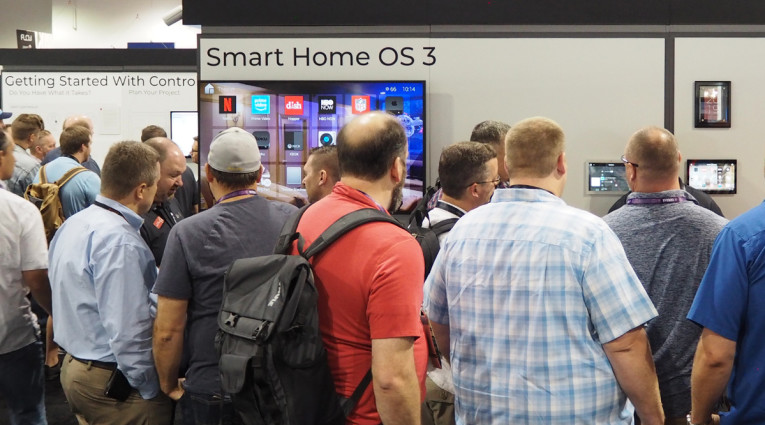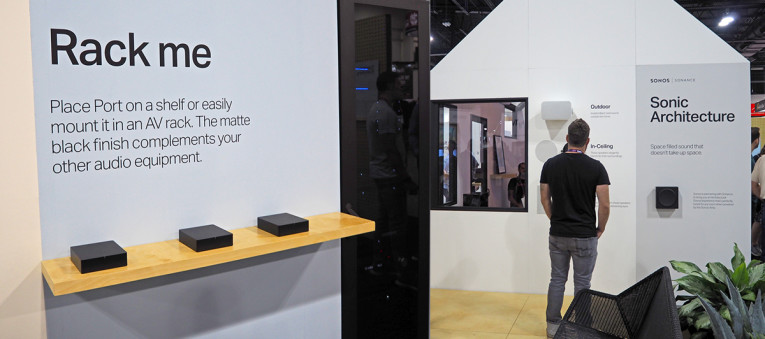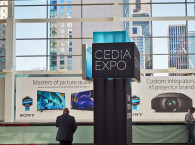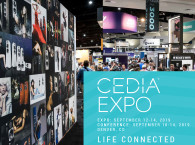
Yes, that big area where Crestron used to be is missing since 2016, and there were less companies exhibiting, mostly as a direct result of recent mergers and acquisitions. But the fact is, the CEDIA Expo visitors' profile remains highly focused on integrators, who are those professionals who have the knowledge and expertise to design, specify, and build home systems. And Crestron has in fact been replaced at the show by new players in the home systems space, including Google, Amazon, Sonos, and others.
CEDIA is the Custom Electronic Design & Installation Association and, as the association states, CEDIA members are "the industry most trusted home technology partners." Notice that reference to "home technology."

When one thinks about home technology, today we think about home automation or what people like to call these days, smart home solutions. The problem is, when there's a reference to "smart home," people essentially think about Google and Amazon ecosystems and, increasingly, voice control. Underlying the topic, there's also Apple's HomeKit concept, which like all things Apple, is omnipresent at shows like this (you don't actually see a booth, but it's everywhere).
Anyway, CEDIA reflects the robust residential integration network of vendors, distributors, and service providers, which in itself is one of strongest market networks, working in sync to provide the best solutions for the home. It is structured upon an extensive network of regional and local retailers, supported by hyperlocal installation providers and service professionals. Not many industries have such an extensive and highly specialized structure - sharing in many aspects the intricate and highly specialized electric power and HVAC installation network that thrives upon the home building and renovation opportunities.
So, any suggestion that the residential integration industry might be in contraction or decline is just wrong. What is happening, like in many other industries, is just that the network itself is adjusting to the wider scope of opportunities allowed by the connected home, while other companies and professionals opt to specialize in certain product segments - home theater being one of those - while broadening their business opportunities in distribution and installation.
Like many other application segments, this is also an industry feeling the effects of technology changes, amplified by a disruption caused by the large players such as Amazon, Google, and others - which in fact would like to work as much as possible with the residential integration industry, not destroy it.

The market represented by CEDIA entails all the systems that fit inside the home, which require a different set of skills and marketing strategies when dealing with home owners and families, not complex organizations like in the commercial sector. Residential integration needs to embrace and expand into a wider range of technologies, from lightning and comfort automation (companies such as Lutron and Legrand seem to fully understand that...), and also needs a better understanding of new disciplines like home security, connected locks, and home communications. That is precisely what Google is promoting with its Google Nest division, and Amazon is successfully doing with Ring (one of the busiest booths at CEDIA Expo 2019).

That is the largest challenge for the industry. Many audio companies exhibiting at the CEDIA show are great at designing in-wall, ceiling speakers and black box rack solutions that the custom installation professionals really appreciate, but their own clients struggle to recognize the value. On the other hand, there's already a new generation of home owners, who actually have a strongest emotional connection with Apple, Amazon or even Sonos or Bose, and actually value acquiring a new smart speaker or soundbar from those companies, more than they do with any other "home" technologies.
That is increasingly a challenge for the home theater segment, which always was and remains one of the strongest application segments for CEDIA. After attending the many excellent home theater demonstrations at this year's CEDIA Expo, I couldn't help thinking that the current consumer is increasingly distant from the products and technologies that make the whole experience. That is in part what explains the strong sales in large screen TVs and soundbars, and the dramatic contraction in sales of integrated AVR amplifiers / processors, which remain essential to the home theater immersive experience.
One thing I couldn't help noticing at this year's show is how the professionals themselves in the residential industry have an emotional connection with the systems exhibited at CEDIA, and are all enthusiastic users of the same systems they are selling. That explains the long lines of people (professionals), eager to attend the DTS, Klipsch, PMC, Theory Audio , or any other great home theater or high-performance audio demonstrations at this year's show. And the fact that I overheard installers repeating the statement that when they are able to provide that same level of excitement to their clients, in their own demonstrations, they are easily able to convince them to buy the products and systems they sell - service included.
The problem is CEDIA is a show for professionals, not end users, and the consumer is currently much more emotionally motivated to invest in a new smartphone or streaming service, than they are about the products and technologies this segment is selling. And consumers have very few opportunities to experience the benefits and advantages of integrated, custom install solutions.

At the same time, Sonos announced a new set of surprising agreements with other manufacturers, working in partnership with Legrand, SnapAV, and Onkyo/Sound United. The agreement with SnapAV is actually a distribution deal, where SnapAV (the new owner of Control4) will sell and integrate the entire range of Sonos' wireless music systems, in a strategy that directly targets the professional custom integrator.

During CEDIA 2019, Onkyo USA confirmed that it will also start selling Sonos' wireless music systems nationwide. The distribution deal includes reselling the Sonos by Sonance architectural speaker line, including promoting those solutions on the Pioneer, Elite, and Integra websites.

A notable paradox, given that Crestron has for the past years been promoting the message at InfoComm that "we can do everything over 1 Gigabit Ethernet," including 4K UHD video distribution for commercial installation, is the fact that the residential sector seems to be quickly embracing broader bandwidth solutions, including Wi-Fi 6, because wireless networks are now faster than Gigabit Ethernet, providing data rates up to 10 Gbps. Very curious.
And I'll leave the analysis of voice trends in home automation control for another article...
This article was originally published in The Audio Voice weekly newsletter. Sign-up here.







